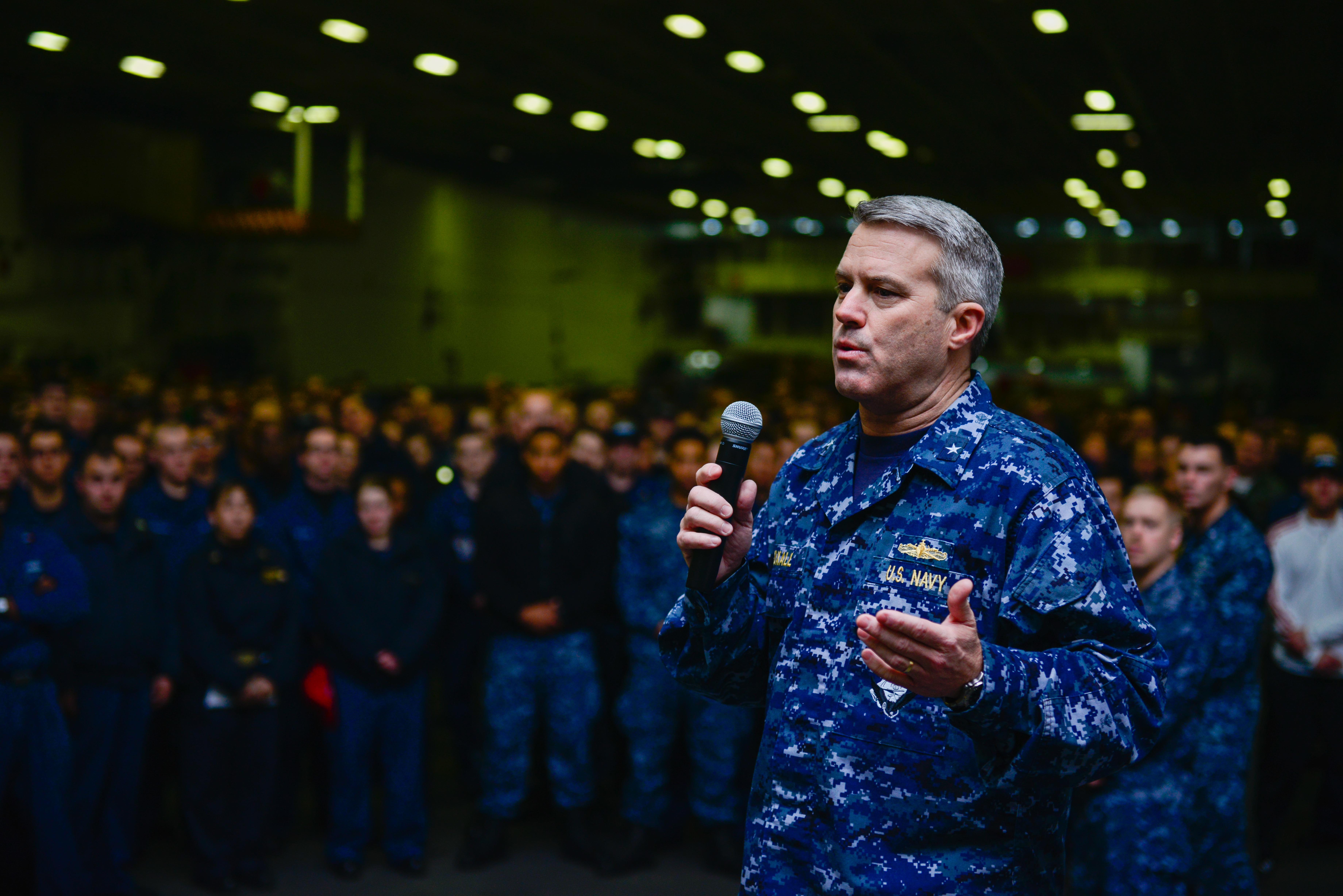
The next six years will bring numerous offensive and defensive capabilities to the surface fleet, culminating in Fiscal Year 2023 when the Flight III Arleigh Burke-class destroyer (DDG-51) reaches initial operational capability and the first frigate delivers to the fleet, the director of surface warfare (OPNAV N96) said last week.
Surface warfare advances in both the small and large surface combatant, that operate in the air, surface and undersea domains, will help move the Navy towards realizing its vision of distributed lethality, where every ship the Navy sails could pose a serious enough threat that an adversary couldn’t ignore any of them.
Upgunning the guided-missile cruisers and destroyers with new surface-to-surface weapons has been the most talked-about effort, Rear Adm. Ron Boxall told USNI News last week, but additional defensive capabilities are an important part of distributed lethality, he added. The Navy is busy looking at assured communications, unmanned systems and the Surface Electronic Warfare Improvement Program (SEWIP) to bolster the destroyers’ ability to protect themselves. The new SPY-6 Air and Missile Defense Radar (AMDR) at the heart of the Flight III design, with 30-times the sensitivity as the legacy SPY-1D(V) radar, is, in a word, “incredible,” Boxall said.
Still, despite the early focus on destroyers, the Littoral Combat Ship and its eventual upgrade to the frigate design will play a huge role in distributed lethality. By 2030, more than half the at-sea surface force will be the LCS and frigate, Boxall said during a presentation at last week’s Surface Navy Association annual conference, and “you’ve got to make those as survivable and capable as possible. And integral to that is the over-the-horizon missile. If you don’t have an over-the-horizon missile on that ship, no one’s worrying about those ships. If you put a good missile on that ship, people are going to have to pay attention to it. There, ladies and gentlemen, is the crux of distributed lethality in surface warfare.”
USS Coronado (LCS-4) is currently deployed with the Harpoon over-the-horizon anti-ship missile in a bolt-on AN/SWG-1A missile launch control system, a configuration that was tested once over the summer at the Rim of the Pacific 2016 exercise but has not been used operationally during the ship’s deployment, Boxall said. He noted that the Harpoon has been around for a long time and the fleet has a good understanding of how it works – the missile is “a great capability, but we want more. We want longer ranges, we want more capability.”

The Navy missed a window of opportunity to test another over-the-horizon missile, the Kongsberg Naval Strike Missile, on USS Freedom (LCS-1) over the summer, before the ship had to go to the yard for a maintenance availability. Rather than wait for additional testing, though, Boxall said the Navy wanted to move ahead with the frigate request for proposals, which he said would be coming out “very soon” and would include capability upgrades including the OTH missile.
“If we have this missile out there and we can afford to do so, we will try to put it as many places as we can. Again, distributed lethality, the more shooters we have out there,” he said, adding that “anything we put on the frigate we will backfit to the LCS” and that ideally all 28 LCSs would get the OTH missile. He also noted the potential to bolt the SWG-1A launcher on cruisers and destroyers and add an additional missile capability to large surface combatants.
“I was a strike group commander and would have loved to have had, even the LCS with a Harpoon we have out there would be a huge improvement over what we have,” he added.
“Anything we continue to do to improve on that against the threats that are out there around the world right now is a step in the right direction.”
Adding more firepower onto the frigates will be supported by an enhanced air search radar, Lockheed Martin Vice President of Littoral Ships and Systems Joe North told USNI News last week at the SNA conference. Lockheed Martin’s frigate design includes the Airbus Defense and Space TRS-4D multi-mode naval radar, but North said the Navy will ultimately select the radar that will be included in the frigate, with the intention of delivering better sensitivity and range compared to the LCS radar.

North said the AN/SPQ-9 radar was the smallest available during LCS design and was still twice the cost of anything the Navy and its LCS builders wanted to use. Since that time, many international companies have been building small but capable radars, he said, noting that they have “followed what the Navy’s been doing and they’ve been putting a lot of upgrades into their systems.” With the upgraded radar, North said a frigate could provide protection for a five-LCS surface action group, for example, and coordinate with other ships in the area for regional protection.
Additionally, the introduction of the frigate – and the eventual introduction of the LCS anti-submarine warfare mission package – will bring great advances in the undersea domain. The SQQ-89A(V)15 and its multi-function towed array (MFTA) are installed on 35 percent of surface combatants today, including one ship in the Carrier Strike Group Boxall commanded, he said in his conference presentation, and it allows for communication between surface ships and submarines. The LCS anti-submarine warfare package and Lockheed Martin’s proposed frigate design also include a variable-depth sonar, which Boxall said is “what we’re using to put a sensor down below the layer where the submarines hang out. Imagine it in concert with another one above the layer from a MFTA ship … and be able to be communicated to other ships that can receive it out there: submarines, maybe aviation components, maybe sonobouys. So this is amazing stuff; when you look at those numbers and all the ships we’re going to have, LCS becomes critical to this.”





